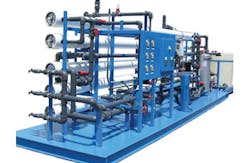Demand for water treatment membrane technologies expected to rise
Innovation and improvement are major driving forces for water and wastewater treatment solution providers. According to a new analysis by consultancy firm Frost & Sullivan, the global market is increasingly opening up to membrane technology as an effective means to produce high-quality effluent.
Membrane technology has advanced dramatically in recent years, thanks to significant investments in research and development. As a result, using the technology has become more viable and more efficient, driving costs further down and making the technology more accessible.
The new report from Frost & Sullivan, called "Membrane Technologies Market in Water and Wastewater Treatment in Southeast Asia," states that the membrane technology market generated total revenues of $249.1 million in 2011 and is expected to reach $398.0 million by 2017. This growth is being fueled by increasing demand from water and wastewater treatment facilities, which are now more willing to invest in membrane technology, the analysis found.
In the past, achieving a satisfactory quality required a bigger number of membranes and higher costs but with the latest development of the technology, facilities of all sizes and capacities are able to afford it, commented Frost & Sullivan research associate Prashanth Kay. While their effectiveness is still the same, membranes are getting smaller and more compact, which makes them perfect for water and wastewater treatment and desalination in particular, Kay added, as quoted by the Filtration and Separation website.
RELATED: North American produced water treatment equipment market to reach $1.2B in 20117
The quality of water effluent can vary significantly, depending on the sector of the water and wastewater treatment industry. Companies that manufacture membrane technologies provide a range of products to ensure that all individual needs are met and ensure the highest possible quality at the lowest possible price.
However, Frost & Sullivan pointed out that water and wastewater treatment based on membrane technology still requires highly-skilled staff to operate the systems, which ultimately means that the technology remains more expensive compared to conventional systems in some countries, despite prices continuing to drop. This is one of the reasons why many representatives of the water and wastewater treatment industry prefer to invest in cheaper and more traditional systems. The trend is particularly strong in water-rich countries, where return in investment from membrane technologies is too low, the report noted.
The market is set to change and the demand for membrane-based water and wastewater treatment will grow, Kay said. The development will be driven by tougher regulations for the industry and by increased demand for purer potable water. Facilities can make their choice by combining different forms of membrane technologies to achieve the best combination for their specific needs, he stated.
The report by Frost & Sullivan is part of the Environmental Growth Partnership Services program, which also looked into other areas of the industry, conducting research on water and wastewater treatment solutions in the food and beverage industry and the electrical and electronics industry.
